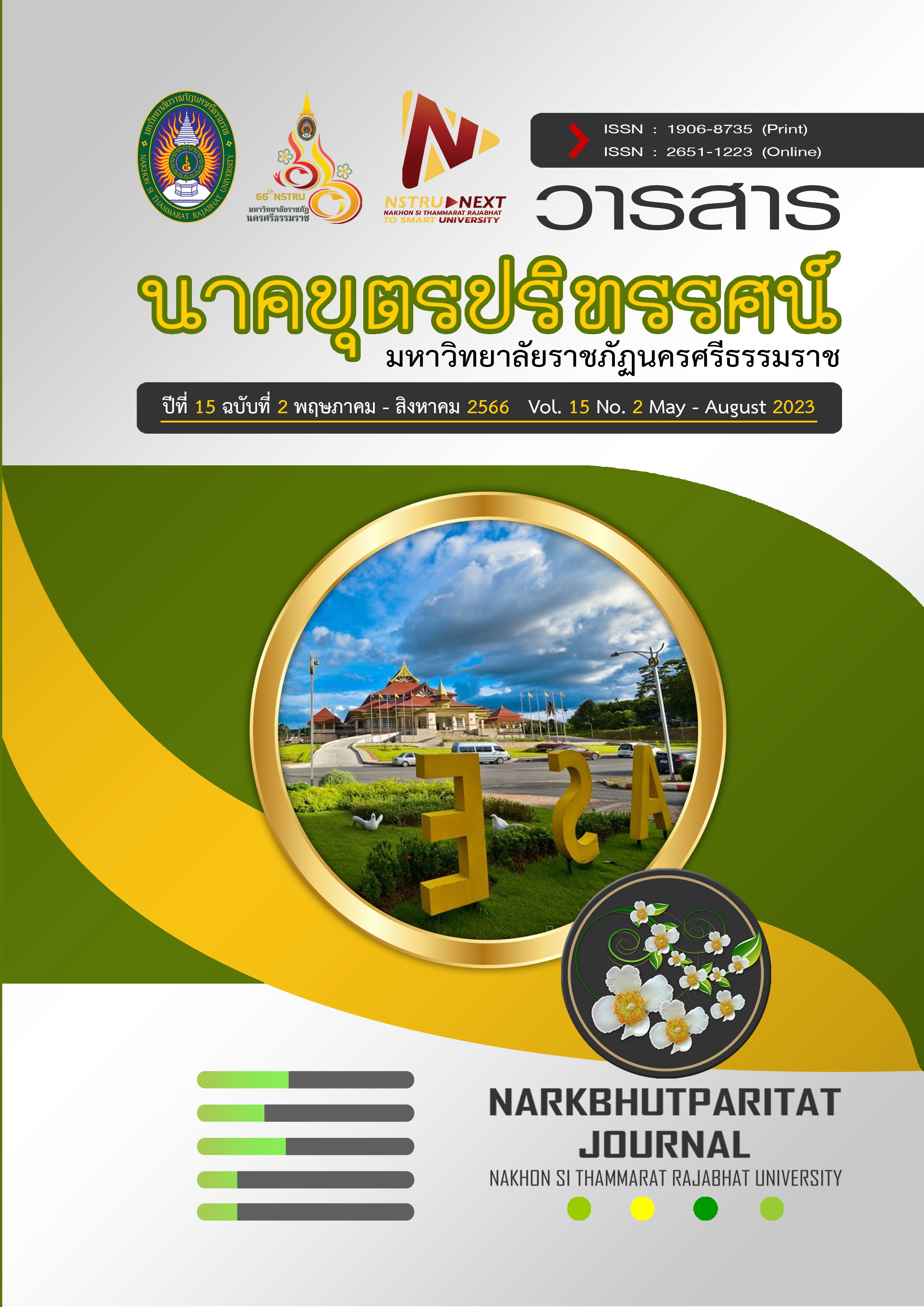“Teachers, I have got something to share!”: NSTRU Students’ Reflections on Online Classes during COVID-19 Pandemic
Main Article Content
Abstract
This research examined students' reflections on university administration, advantages, and obstacles they encountered while studying online during COVID-19 Pandemic in 2020-2021. The sample consisted of 357 undergraduate students who were randomly selected to answer the questionnaire. Other 19 volunteered students were interviewed to validate the quantitative data. The questionnaires were analyzed through descriptive statistics (mean and standard deviation) and content analysis was employed for the interview data. The results from quantitative and qualitative methods were concomitant. The quantitative results indicated that the top three reflections on management were imposing policy and plan, organizing teaching and learning activities, and follow-up and learning assessment ( = 4.21, 4.15, 4.06, respectively). The advantages of online learning were reducing the pandemic, convenience to study and saving time, and increasing digital literacy (
= 4.50, 4.18, 4.18, respectively). The interview results confirmed all these findings. The key findings on obstacles the students encountered were the inconvenience in doing group work with whelming homework, the low capability of mobiles and electronic equipment, and lack of motivation (
= 4.18, 4.05, 3.82, respectively). The emerging interview results revealed that the students' smartphones or computers performed low capacity to produce quality work, and had physical and mental health deterioration. The students' reflections on advantages can be used to fine-tune policy, plan, systems, and measures to serve the students' needs whereas the disadvantages can be considered in remodeling the policy and measures to prevent or reduce chronic problems in the long run.
Article Details

This work is licensed under a Creative Commons Attribution-NonCommercial-NoDerivatives 4.0 International License.
References
Announcement of the Ministry of Higher Science Education Research and Innovation on Measures and Surveillance of the Coronavirus Disease 2019 (COVID-19) (2020). Ministry of Higher Education, Science, Research and Innovation. Retrieved 2021, October 19, from https://www.ku.ac.th/web-upload/fck/editor-pic/files/covid-mhest3-thai.pdf. (in Thai)
Bryman, A. (2016). Social Research Methods (5thed). London: Oxford University Press.
Ferri, F., Grifoni, P., & Guzzo, T. (2020). Online learning and emergency remote teaching: Opportunities and challenges in emergency situations. Societies, 10(4), 86.
Chutipascharoen, A &Krootjohn, S. (2023). The Impact of Covid-19 on Higher Education Teaching: A guideline for online teaching by using league learning. Udon Thani Rajabhat University Journal of Humanities and Social Science. 12(1), 87-102. (in Thai)
Indrayan, A., & Holt, M. P. (2016). Concise encyclopedia of biostatistics for medical professionals. CRC Press. (e-book)
Intharaksa, P.(2019). Learning management with social media. Journal of Education Naresuan University, 21(4), 357-365. (in Thai)
Isaias, P., Sampson, D. G., & Ifenthaler, D. (2020). Online Teaching and Learning in Higher Education. Cham: Springer International
Publishing.
Khan, M. A., Nabi, M. K., Khojah, M., & Tahir, M. (2020). Students’ perception towards e-learning during COVID-19 pandemic in India: An empirical study. Sustainability, 13(1), 1-14.
Krejcie, R. V., & Morgan, D. W. (1970). Determining sample size for research activities. Educational and psychological measurement, 30(3), 607-610.
Mayring, P. (2014). Qualitative content analysis: theoretical foundation, basic procedures and software solution. Gesis–Leibniz Institute for the Social Sciences. Retrieved 2022, February 22, from https://rb.gy/gxv31k
Mishra, P., Pandey, C. M., Singh, U., Gupta, A., Sahu, C., & Keshri, A. (2019). Descriptive statistics and normality tests for statistical data. Annals of cardiac anaesthesia, 22(1), 67.
Murairwa, S. (2015). Voluntary sampling design. International Journal of Advanced Research in Management and Social Sciences, 4(2), 185-200.
Paudel, P. (2021). Online education: Benefits, challenges and strategies during and after COVID-19 in higher education. International Journal on Studies in Education, 3(2), 70-85.
Pawangkanan, T. (2021). Educational Administration in the Covod -19 Outbreak Situation in New Normal Living. Journal of Bovorn Multi-Education and Human Social Sciences. 2 (2) (July –December), 25-32
Sawangnuwatkul, N. (2021). The determinants toward fostering innovation management effectiveness in Thai public service: Empirical study of awarded organization. Journal of Social Academic, 14(2), 1-19.
Smart, B. M., & Saxon, D. P. (2016). Online versus traditional classroom instruction: An examination of developmental English courses at an Alabama community college. Community College Journal of Research and Practice, 40(5), 394-400.
Snyder, T.D., de Brey, C., & Dillow, S.A. (2018). Digest of Education Statistics 2016 (NCES 2017-094). National Center for Education Statistics, Institute of Education Sciences, Washington, DC: Department of Education.
Stelitano, L., Doan, S., Woo, A., Diliberti, M., Kaufman, J. H., & Henry, D. (2020). The digital divide and COVID-19: Teachers' perceptions of inequities in students' internet access and participation in remote learning. Santa Monica: Rand Corporation.
Xhaferi, B., & Xhaferi, G. (2020). Online learning benefits and challenges during the COVID-19 Pandamic-Students’ Perspectives from SEEU. SEEU Review. 15(1), 86-103.
Zeegen, E. N., Yates, A. J., & Jevsevar, D. S. (2020). After the COVID-19 pandemic: Returning to normalcy or returning to a new normal? The Journal of arthroplasty, 35(7), S37-S41.


